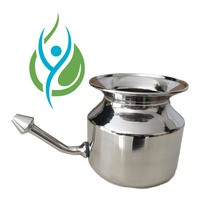
Spring
marks the beginning of the allergy season. Before you reach for expensive over
the counter or prescription allergy remedies for hay fever, seasonal allergies
or chronic sinusitis, you might want to try an inexpensive alternative
treatment that really seems to work not only as a treatment but a remedy as
well.We are talking about nasal
irrigation, or washing out your nose once or twice daily with a warm salt water
brine.
Nasal/sinus irrigation simply washes away the irritants causing the allergy
symptoms. Nasal irrigation is useful not only for symptom relief when your
allergies or sinuses are acting up, but also for routine “cleansing.”
Many
medical institutions, such as the Mayo Clinic, advocate the use of nasal
irrigation. A study undertaken in children in
2009 found that nasal saline irrigation significantly eased symptoms while
lessening the need for medications like steroid nasal sprays.
The Neti Pot, which looks like a little oil lamp, often used by yoga devotees
is used to perform the nasal irrigation. The Neti Pot as we call it was
originally known as the Jala Neti used in the ancient Indian practice of
Ayurveda which is the traditional Hindu system of medicine (based on the idea
of balance in bodily systems and practices diet, herbal treatment, and yogic
breathing).The basic idea of the neti
pot procedure was to irrigate the nasal and sinus passage with a natural salt
brine to gently flush away and clear any irritation causing allergy symptoms
and sinus infections and provide the body with an opportunity to heal itself.
Historical practitioners have used Neti Pots in cleaning rituals and health programs for centuries.The Neti Pot is used to pour warm salty brine water into one nostril (when the patient is leaning forward) and allow it to run out the other.
Nasal irrigation, is beneficial not only because of the therapeutic effects of salt, but also due to the physical flushing that helps remove irritants. I recommend you avoid using commercial processed salts and instead use a high-quality sea salt or Himalayan Salt for irrigation.
The Nasal Irrigation Procedure
Nasal irrigation takes a bit of getting used to, but once you learn the technique you’ll see how easy and comfortable it is.
You will need a ‘Neti Irrigation Kit’ that has the following:
• Filtered or distilled water – 450mls (a little under 2 cups measurements)
• Stainless Steel Neti Pot
• Towel, tissues or washcloth
The technique, outlined below, may seem unusual at first. However, once learned, you will quickly realize how beneficial it can be.
1. The stainless steel Neti Pot is specially designed
with a spout that fits comfortably in one nostril.
2. Heat water until it reaches body temperature and pour the warm water into
the Neti Pot. The best temperature is 36˚C
or 98˚F or a little warmer if well tolerated but it is important to test the
water first so that you do not burn your nasal passage.Keep in mind that you do not want the water
to cool too quickly because experience has shown us that cold water will tend
to close up the nasal passage and not dissolve the mucus well.The stainless steel Neti Pot will keep the
water warmer for longer than other devices on the market.
3. Add the salt to the water and make sure that all
the salt dissolves. The salt-to-water ratio is 1 teaspoon salt to 1 pint (2
cups) water. Filtered or distilled water is best.
4. Some people prefer to perform the irrigation in the shower, however if you
are doing this over the sink, we recommend you have some tissues or a towel handy.
When you are ready to start, lean over a sink, tilt
your head forward so you are looking directly down toward the sink. Insert the
spout into your right nostril. It is important that you breathe through your
mouth. Turn your head to the right and let water move into the right nostril
and exit the left nostril. Normally, you will feel the water as it passes
through your sinuses. This will be an unusual feeling at first but after doing
it the once, you will see how easy it really is.
It is fine if some of the water drains into your mouth. Simply spit it out and adjust
the tilt of your head.
5. After using a half of the water brine, repeat the above procedure for the
other nostril.
6. To finish, expel any remaining water by quickly blowing air out both open
nostrils 15 times over the sink or in the shower. Avoid the temptation to block
off one nostril, as doing so may force water into your eustachian tube.
It is important to follow all the instructions very
carefully and continue the routine until all your symptoms resolve. This may
take three to six months in the case of a chronic infection, so be patient. For
acute problems like seasonal allergies, perform the nasal wash up to four times
per day until your symptoms improve.
For chronic problems like sinus infections, it is usual to do the wash one or
more times daily and continue for several months.
Studies
Li H1, Sha Q, Zuo K, Jiang H, Cheng L, Shi J, Xu G, 2009.Nasal saline irrigation facilitates control of allergic rhinitis by topical steroid in children.
ORL J Otorhinolaryngol Relat Spec. 2009;71(1):50-5. doi: 10.1159/000178165. Epub 2008 Dec 1.
